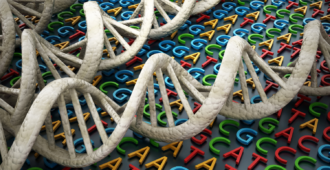It’s taken a huge international collaboration, including 3 MND Association-funded scientists, to discover a genetic mistake that appears to cause almost 40% of cases of familial (inherited) MND – that’s nearly twice as many as are caused by mutations in the SOD1 gene and more than three times as many as are caused by TDP-43 and FUS combined. Yet despite the fact that it’s relatively common, the rogue gene proved especially difficult to find.
Digging for genes
Our genetic code is arranged into 23 pairs of subunits called chromosomes. Earlier work had homed in on an area on chromosome 9 that appeared to be significantly associated with both MND and the related neurodegenerative disease frontotemporal dementia (FTD), but nobody could drill down as far as the problem gene itself. As a result, chromosome 9 became something of an ‘archaeological dig site’ for MND researchers, with several groups using cutting edge techniques to try and excavate the elusive causative gene that they knew was lurking somewhere in the short arm of this chromosome. The successful international team, which included almost 60 scientists at 37 institutes, finally discovered the exact location and nature of the aberrant genetic code by looking in the most unlikely of places – in the stretches of DNA that do not actually provide any instructions for building proteins, otherwise known as non-coding DNA.
What did the researchers unearth?
The research team studied DNA samples from a Welsh family affected by inherited MND and FTD that was already known to be associated with chromosome 9, as well as samples from a similar Dutch family and a large number of Finnish inherited and non-inherited MND cases. In among the non-coding DNA in a chromosome 9 gene called C9ORF72, the researchers found a 6-letter genetic ‘word’ which, in healthy individuals, is consecutively repeated up to about 20 times. However, in the Welsh and Dutch families and a large proportion of the Finnish familial cases, the 6-letter word was repeated as many as 250 times. This phenomenon is known as a ‘repeat expansion’. The researchers went on to check for this repeat expansion in familial MND cases from North America, Germany and Italy, and found it cropped up in 38% of them. They even found it in a much smaller proportion of sporadic cases from Finland, suggesting that it could be an important risk factor in at least some people with the non-inherited form of the disease.
What does the discovery mean for MND research?
Despite the fact that the repeat expansion does not directly affect the instructions for building a protein, there is good reason to believe that it can still lead to significant neuronal damage. At the moment it is not fully understood how this happens, but one possibility is that it leads to the production of excessive and consequently toxic quantities of RNA, the molecule that provides the cell with a more usable copy of DNA. Disruption to RNA processing has already been implicated as a disease mechanism in MND – this is the pathway through which faulty TDP-43 and FUS are thought to exert their effects – so C9ORF72 may provide scientists with another piece of the RNA jigsaw.
The effect of the repeat expansion is clearly open to influence. Among those people with the repeat expansion, some experienced only FTD, others showed only muscle weakness, and some had both MND and FTD. The reasons for this variation in symptoms will be just one area that scientists will now want to look into. This overlap between MND and FTD is something that researchers are very keen to understand, and the C9ORF72 discovery may be the key to solving this puzzle. They will also want to better understand how the repeat expansion causes damage, and that will include trying to find out what C9ORF72 actually does – at the moment this is unknown. (Maybe it’ll get a more interesting name along the way!) Building on the new finding in this way could help move us closer to an effective treatment.
For now, a more tangible consequence of the discovery could be a genetic test for people already diagnosed with familial MND who want to understand more about the basis of their disease. Such a test will take a little time to develop but should become available in the UK in the next few months. When it does, it will be accessible to genetics labs across the country. Anyone interested should speak to their doctor or specialist nurse.
Dead heat
Just as archaeologists might question whether a newly discovered artefact is the real thing, so scientists need double-checking when they claim to have made a new discovery. Fortunately, a second team hit upon C9ORF72 at exactly the same time, and their results will be published alongside the work described here, in the journal ‘Neuron’. The race to the ‘Lost Ark’ of chromosome 9 ended in a tie, but has provided the research community with a major piece of the MND puzzle on which to build future discoveries.
Article: Renton A, Majounie E, Waite A et al. A hexanucleotide repeat expansion in C9ORF72 is the cause of chromosome 9p21-linked amyotrophic lateral sclerosis-frontotemporal dementia. Neuron (2011).






I wonder if chromosome 9 is where our familial MND gene lies?
Hi Margaret, thank you for posting a comment.
If you are affected by familial MND and the person with the disease is still alive, then you may be able to find out if they have this particular genetic mistake in the next few months. We have been informed that the tests will be available by January 2012, and this would be done through the ‘normal’ procedures – their neurologist will know where to send the samples for testing once it is available. If the person with MND is no longer alive, then I’m afraid it will not possible to take this test to find out if this is the gene that has caused the disease in your family.
Research Development Team
All the suffers of MND ,,,my great aunt, mother, sister, cousin and two uncles have passed but we have DNA collections of living family members at the Anzac Research familial MND Programme at Concorde … we don’t know where or when it will strike a family member.
thank you
Margaret
.
Like Margaret, My family both in NZ and Australia have contributed to DNA collection through the ANZAC Research familail MND programme at Concorde… This news is very exciting for us finding another link. My mother had MND with dementia and now my brother has recently been diagnosed at 53 and his MND is progressing quickly… It provides hope for our children.
thanks for the incredible patience it taken to make this discovery
I am very interested in finding out when this genetic testing might be available in the US. My father was recently diagnosed with ALS-FTD and, while we don’t know of a family history of ALS, there are several members of my father’s paternal side that were reported to have dementia in later years. I am told that, while they didn’t show ALS symptoms, his disease might still have been inherited.
Hi Tracy,
I’m afraid we don’t know when the test will be made available in the US – if you’re interested in finding out more information, we would suggest that you speak with your neurologist.
I hope this helps,
Kelly